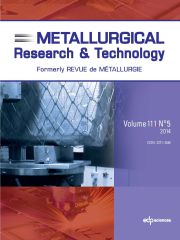Article contents
Influence of surface conditions on fatigue strength through thenumerical simulation of microstructure*
Published online by Cambridge University Press: 06 July 2011
Abstract
A thermal fatigue test (INTHERPOL) was developed by EDF in order to study the initiationof cracks. These tests are carried out on tubular specimens under various thermal loadingsand surface finish qualities in order to give an account of these parameters on crackinitiation. The main topic of this study is to test the sensitivity of different fatiguecriteria to surface conditions using a micro/macro modelling approach. Therefore a 304Lpolycrystalline aggregate, used for cyclic plasticity based FE modelling, have beenconsidered as a Representative Volume Element located at the surface and subsurface of thetest tube. This aggregate has been cyclically strained according to the results issuedfrom FE simulation of INTHERPOL thermal fatigue experiment. Different surface parametershave been numerically simulated: effects of local microstructure and of grainsorientation, effects of machining: metallurgical prehardening, residual stress gradient,and surface roughness. Three different fatigue criteria (Manson Coffin, Fatemi Socie anddissipated energy types), previously fitted at a macroscale for thermal fatigue of 304L,have been computed at a meso scale, in order to show the surface “hot spots” features andtest the sensitivity of these three criteria to different surface conditions. Results showthat grain orientation and neighbouring play an important role on the location of hotspots, and also that the positive effect of prestraining and the negative effect ofroughness on fatigue life are not all similarly predicted by these different fatiguecriteria.
Keywords
Information
- Type
- Research Article
- Information
- Copyright
- © EDP Sciences
References
- 3
- Cited by

